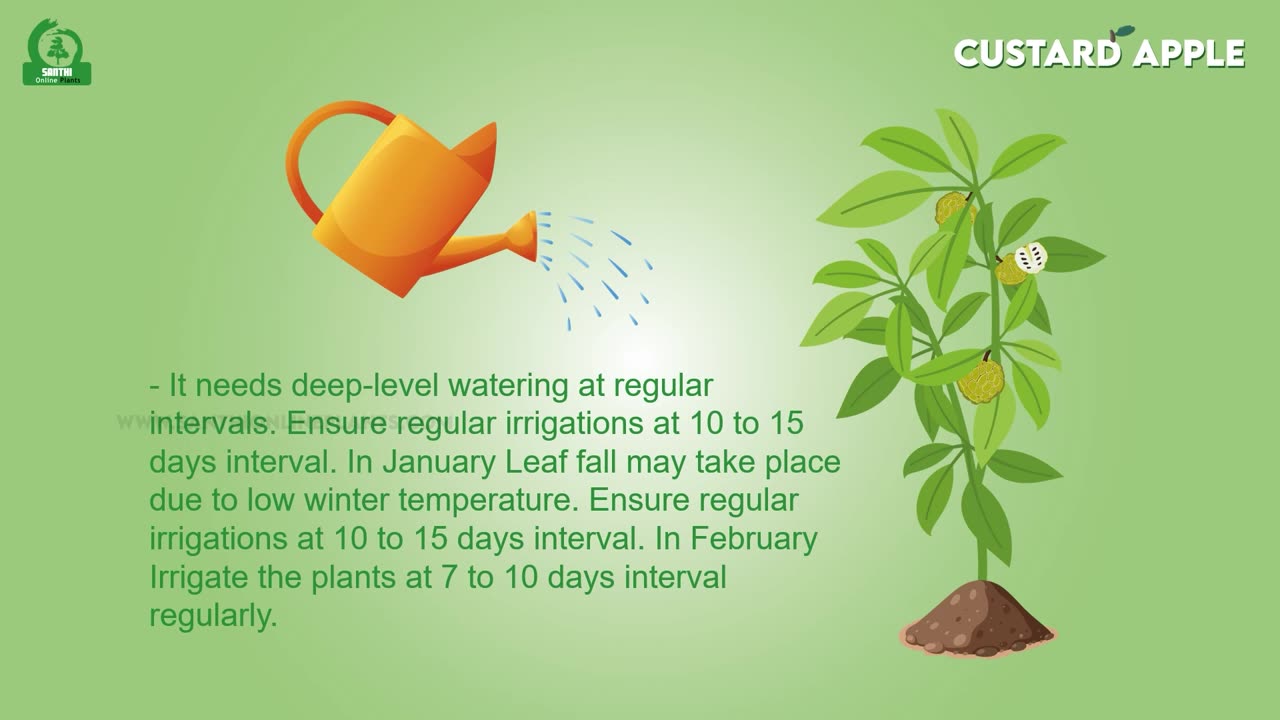Premium Only Content

CUSTARD APPLE
https://www.santhionlineplants.com
CUSTARD APPLE
The custard apple is also known as Seethapazham. It is a very sensitive fruit and aggregate fruit-bearing plant. The fruit has high medicinal value.
CUSTARD APPLE COMMON NAME: Sugar Apple, Seethapazham, Sitapal.
CUSTARD APPLE PLANT
The plant is a semi-evergreen tree and climacteric fruit plants can’t tolerate frost, especially young and fruit-bearing plants. Sitapal plants need to grow well in wind-free, frost-free, and humid places.
CUSTARD APPLE TREE
The custard apple tree is woody, and brown and produces numerous branches. It can thrive up to 8 to 12 feet tall. These plants can grow in the garden or outdoor areas.
CUSTARD APPLE FLOWER
Custard apple plants produce flowers on the emerging shoot and 1 to 2-year-old wood. This flower is fragrant, long and slender, and light green to pale yellow with purple spots. During spring to summer, flowers bloom in a hot dry climate, and fruit sets in high humidity.
CUSTARD APPLE LEAF
The leaves are glabrous, leathery, dark green to wooly green, and have smooth margins. Leaf has good medicinal properties it helps treat diabetes and digestion problems.
Annona reticulata
Annona reticulate is the scientific name of the custard apple plant it belongs to the Annonaceae family. It is under the category of the tree, fruit plant, and outdoor plant
CUSTARD APPLE FRUIT
Fruit are irregular in shape, green in color, multi-segmented, and have white flesh pulp. To bear fruit in 3 to 4 years from August to November. This fruit is also known as sitapal and it is a sweet, creamy, tasty, and edible fruit.
SOIL
Flourish on any type of soil but is ideal for the deep black, well-draining soil with highly rich organic content.
SUNLIGHT
It requires adequate direct sunlight for at least 6 to 8 hours per day. Summer keeps the plant in a green shade net.
WATERING REQUIREMENT
It required more water to keep the soil damp and again water the plant when the top 1-inch of soil feel dry. In winter, to reduce water consumption.
RANKING OR TILLING
Tilling is used to loosen up your soil before applying fertilizer and provide good aeration.
FERTILIZER APPLICATION
Apply any organic fertilizer like cow manure, blood meal, citrus fertilizer, and vermicompost in early spring once every 3 months until the tree begins to bear fruit. Develop plant growth, supply nutrients to plants, and boost tree tolerance to heat and cold.
TRANSPLANTING
Once seedlings are mature they can be transplanted into the garden or a slightly larger pot. It was good for root development, good aeration, and fruit production.
PRUNING
The pruned plant is bushy and maintains a low height because the tall plant is unstable in the pot. To remove the dry, affected, and dead branches and encourage plant growth.
PEST AND DISEASE
Due to improper management practices, pests like aphids and mealybugs are attacked. It prevents plant growth and reduces fruit bearing.
CONTROL
Spray neem oil with liquid soap once a week to kill and control pests and diseases. Take 1 ml of neem oil and 1 ml of liquid soap to mix in 1 liter of water and shake well. It makes plants healthy and increases fruit production.
CUSTARD APPLE BENEFITS
Custard apple fruit is highly rich in vitamins, minerals, and fibers.
Potential uses for custard apples are skin, hair, cancer, diabetes, and digestion problems.
Leaf extract has strong anti-microbial properties; it helps to reduce bacteria, fungi, and viruses.
PRECAUTION
Pregnant women should consult their doctor before eating custard apple fruit.
https://www.santhionlineplants.com
-
 1:01:01
1:01:01
TheTapeLibrary
11 hours ago $0.65 earnedThe Horrifying True Story of Summerwind Mansion
4.06K2 -
 29:28
29:28
Afshin Rattansi's Going Underground
1 day agoMax Blumenthal on US’ Ukraine Aid Corruption, 'Psychotic' Israel Turning the West Bank into Gaza
15.8K1 -
 57:13
57:13
Sarah Westall
3 hours agoUnited States in a Two Front War, Identify Military Psyops and Special Operations w/ Jeffrey Prather
17.7K4 -
 DVR
DVR
Quite Frankly
7 hours ago"Open Phones: D.C. Crash, Senate Hearings, Petty Break-Ups" 1/31/25
22.6K7 -
 1:45:32
1:45:32
2 MIKES LIVE
6 hours ago2 MIKES LIVE #173 Open Mike Friday!
29.9K1 -
 54:53
54:53
LFA TV
10 hours agoDemocrats’ Greatest Fear Is Accountability | TRUMPET DAILY 1.31.25 7pm
21.9K6 -
 23:15
23:15
Bare Knuckle Fighting Championship
1 day agoBKFC FIGHT NIGHT MOHEGAN SUN FREE FIGHTS
23.4K2 -
 5:49:46
5:49:46
Bitfinex
9 hours agoBitfinex Talks Live at PlanB El Salvador - Day 2
26.7K2 -
 41:47
41:47
Candace Show Podcast
6 hours agoBecoming Brigitte: An Introduction
129K216 -
 1:27:41
1:27:41
vivafrei
7 hours agoBernie Gets DESTROYED! Confirmation Hearings RECAP! D.C. Aviation Disaster & MORE!
114K85